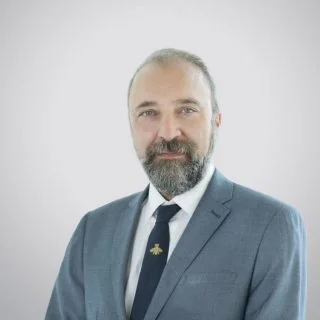The doctors at King’s College Hospital Dubai Department of Orthopaedics are at the forefront of treatments of the hand, wrist and elbow and specialise in minimally invasive arthroscopy (keyhole surgery). Our team can also support patients as they recover, using the latest custom-made devices (orthotics) and technology to help speed up healing and recovery time. We offer all our patients a personalised rehabilitation programme to help them recover as quickly as possible.
Hand & Wrist conditions that we diagnose and treat include:
- Dupuytren’s contracture: more common in men than women, this is caused by thickening and tightening of the tissue beneath the skin of the palm and fingers. No one is certain what causes the condition but it causes the fingers to curl towards the palm, making it difficult to hold large objects or put your hand in your pocket. Surgery involves dividing or removing the thick bands to improve your range of finger movement.
- Fractures: including all types of distal radius fracture (affecting the forearm near the wrist); scaphoid fracture (below the thumb); thumb fracture; finger fractures.
- Ganglions: harmless fluid-filled cysts that develop in joints in the hand (often on the back of the wrist). They can vary in size and don’t always need treatment. However, if necessary, the ganglion can be removed during arthroscopy (keyhole surgery) and most people can return to their everyday activities within two to four weeks.
- Kienböck’s disease: caused by lack of blood supply to a small bone in the wrist called the lunate. This can cause the bone to die (osteonecrosis) and can lead to pain, stiffness and arthritis.
Nerve injuries including:
- Carpal tunnel syndrome (CTS), affecting a narrow ‘sheath’ beneath the base of the palm that’s formed by small bones in the wrist and a band of connective tissue. A nerve known as the median nerve passes through the tunnel from the forearm to the hand and controls sensation in the thumb, index finger, middle finger and ring finger and muscles in the base of the thumb. Tendons also pass through the tunnel. Carpal tunnel syndrome is caused when the sheath is too tight, putting pressure on the nerve and causing pain and tingling.
- Cubital tunnel syndrome, caused when the ulnar nerve is compressed. This nerve travels from the shoulder to the hand, passing through a small tunnel on the elbow (the cubital tunnel). If this becomes blocked, the nerve is trapped and causes tingling in the little finger and half of the ring finger.
- Ulnar tunnel syndrome occurs when the nerve from the neck to the hand is compressed, often by a ganglion on the wrist joint. This causes numbness that can affect the little finger, as well as weakness and pain.
- Osteoarthritis: pain and irritation of the cartilage in the joints of the hand which can limit movement; it can also affect the base of the thumb and wrist.
- Ligament injuries including sprained thumb and sprained wrist.
- Tendon injuries including flexor tendon injury; Boutonniere deformity; trigger finger/thumb; and De Quervain’s tendinosis.
Elbow Conditions Including
We can treat and manage complex elbow conditions including elbow stiffness and instability and have many years’ experience of performing joint replacement surgery for serious joint damage. Where possible, we use minimally invasive techniques such as arthroscopy (keyhole surgery) and we offer our patients a personalised rehabilitation programme to help them recover as quickly as possible.
Faqs
الأسئلة الأكثر شيوعا
These warning signals may point to the necessity for hand surgery whereby non-surgical options are ineffective; numbness and pain that makes performing tasks difficult, your range of motion is constrained and underlying medical conditions such as Tendinopathies, Trigger finger, Carpal Tunnel syndrome, or nerve damage.
Your surgeon will evaluate your health, the type of surgery you need, and other considerations when determining whether you need general anaesthesia for your hand surgery. A local anaesthetic may work well for patients having surgery for carpal tunnel syndrome or tendon repair but, general anaesthesia may be preferable for more difficult procedures involving the bones such as those necessary to treat fractures.
Often not. Numbness following Carpal Tunnel Surgery may or may not go away quickly depending on several variables. They include the degree of median nerve compression, the results of electrical nerve testing, and the kind of surgery performed. Patients who are at risk for poor surgical results include those with diabetes, thyroid illness, and muscle atrophy whose numbness may last up to 40 months post-surgery.
Casts aid in keeping the hand stationary, which reduces pain. You should be given instructions on how to shower and maintain a clean, dry cast. In the early stages of healing, bleeding is normal. However, if your bandages get drenched call your doctor.
Your surgeon determines physical rehabilitation following surgery. Timing is crucial when it comes to therapy. Therapy can hinder recovery if started too soon or the hand could stiffen up if you wait too long. Have a professional hand therapist guide you through your healing window.
Your recovery time following hand surgery will vary depending on the procedure’s complexity and the hand surgeon’s chosen method. Minimally invasive hand surgery patients typically heal faster than those who have open surgery. You can speed up your recovery from hand surgery by adhering to your physical therapy and rehabilitation exercises.
BOOK AN APPOINTMENT









